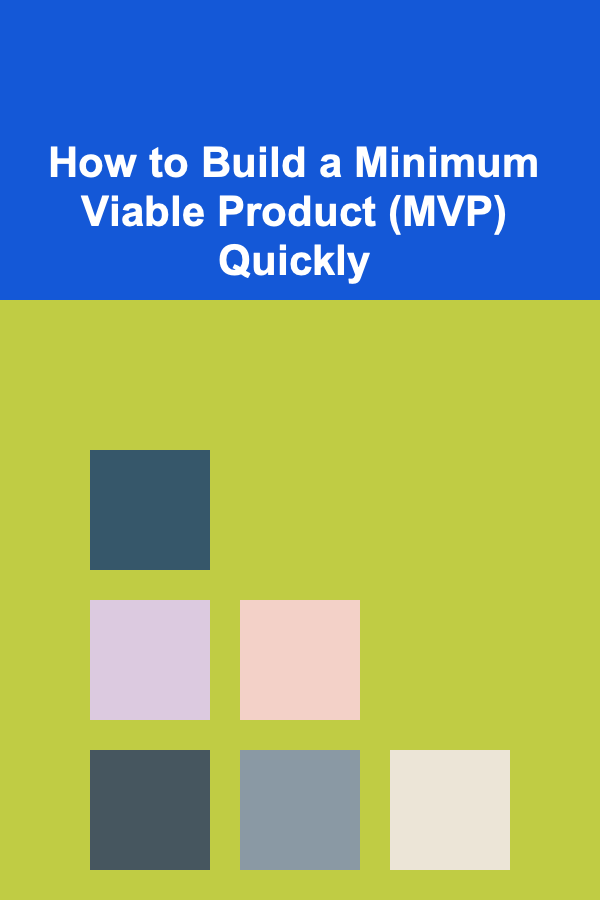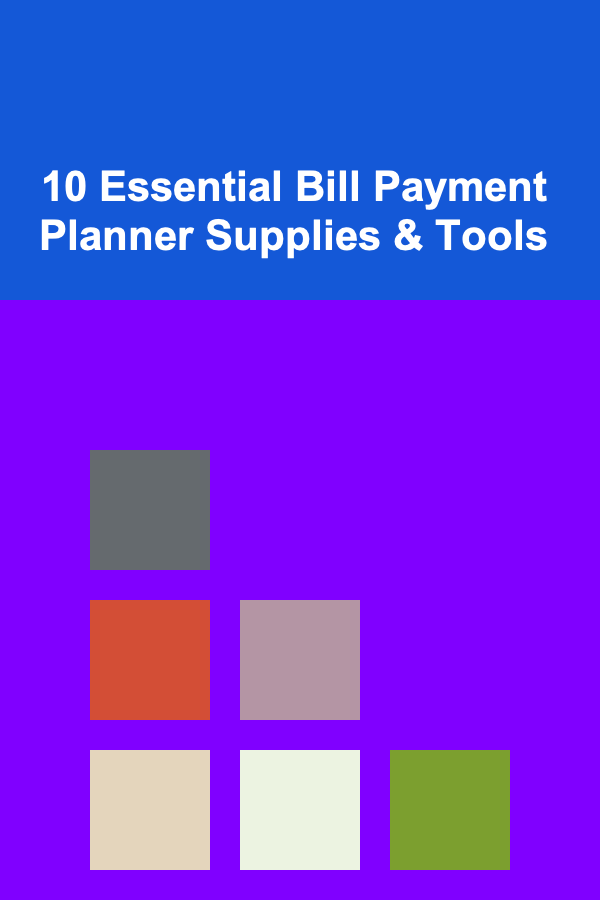
How to Build a Minimum Viable Product (MVP) Quickly
ebook include PDF & Audio bundle (Micro Guide)
$12.99$5.99
Limited Time Offer! Order within the next:

In today's fast-paced business environment, the ability to rapidly test and validate ideas is crucial for success. Building a Minimum Viable Product (MVP) is a popular approach for quickly launching a product with core features to gather valuable user feedback and iterate accordingly. This article provides a comprehensive guide on how to build an MVP quickly, covering essential steps, strategies, and best practices.
Understanding the Minimum Viable Product (MVP)
Before diving into the how-to, it's crucial to define what an MVP truly is. The term "Minimum Viable Product" was popularized by Eric Ries in his book "The Lean Startup." It's not simply a prototype or a stripped-down version of your final product. Rather, it's the version of a new product which allows a team to collect the maximum amount of validated learning about customers with the least effort.
Key Characteristics of an MVP:
- Functionality: Contains the core features necessary to solve a key problem for your target audience.
- Usability: Provides a functional and reasonably usable experience, even if not perfectly polished.
- Reliability: Performs reliably enough to allow users to complete their tasks without excessive frustration.
- Sufficiency: Offers sufficient value to attract and retain early adopters who are willing to provide feedback.
Why Build an MVP?
- Validate your assumptions: Test whether your product idea resonates with your target audience.
- Reduce development costs: Avoid building features that users don't need or want.
- Accelerate time to market: Launch a product quickly and start generating revenue sooner.
- Gather early user feedback: Learn from real users and iterate based on their needs.
- Attract early adopters: Build a loyal customer base who can champion your product.
- Secure funding: Demonstrate traction and potential to investors.
The MVP Building Process: A Step-by-Step Guide
1. Define Your Target Audience and Problem
The foundation of a successful MVP is a clear understanding of your target audience and the problem you're trying to solve. Without this, you're essentially building in the dark. Take the time to conduct thorough market research and define your ideal customer persona(s).
- Identify your target audience: Who are you building this product for? What are their demographics, psychographics, and behaviors?
- Define the problem: What pain points are you addressing? What unmet needs are you fulfilling?
- Validate the problem: Are people actively searching for a solution to this problem? Are they currently using workarounds?
Use surveys, interviews, and competitor analysis to gather data and validate your assumptions. Tools like Google Forms, SurveyMonkey, and Typeform can be helpful for conducting surveys. For interviews, focus on open-ended questions that encourage users to share their experiences and perspectives. Analyzing competitor products can reveal their strengths and weaknesses, helping you identify opportunities for differentiation.
2. Prioritize Core Features: The Art of Saying No
This is perhaps the most critical step in building an MVP. The temptation to include every feature imaginable is strong, but resist the urge! The goal is to identify the absolute minimum set of features required to solve the core problem for your target audience.
Feature Prioritization Techniques:
- Moscow Prioritization: Categorize features into four groups: M ust have, S hould have, C ould have, and Won't have (for now). Focus solely on the "Must have" features for your MVP.
- Impact/Effort Matrix: Plot features on a matrix with "Impact" on one axis and "Effort" on the other. Prioritize features with high impact and low effort.
- User Story Mapping: Create a visual representation of the user's journey and identify the essential tasks required to complete it. Focus on building the features that support these essential tasks.
Example: Let's say you're building a task management app. Potential features could include task creation, task assignment, deadlines, subtasks, project management, collaboration features, reporting, and integrations with other tools. For an MVP, you might prioritize only task creation, task assignment, and deadlines. Subtasks, project management, and other features can be added later based on user feedback.
3. Choose the Right Technology Stack
Selecting the right technology stack is crucial for building an MVP quickly and efficiently. Consider factors such as your team's existing skills, the complexity of the project, and the scalability requirements.
Considerations for Technology Selection:
- Team Expertise: Use technologies that your team is already familiar with to minimize the learning curve.
- Rapid Development Frameworks: Leverage frameworks that provide pre-built components and tools to accelerate development. Examples include:
- Web Development: React, Angular, Vue.js, Ruby on Rails, Django, Laravel
- Mobile Development: React Native, Flutter, Ionic
- Backend Development: Node.js, Python, Go
- Low-Code/No-Code Platforms: Consider using low-code or no-code platforms like Bubble, Webflow, or Airtable for simple MVPs. These platforms allow you to build applications with minimal coding.
- Scalability: Choose technologies that can scale as your product grows. Cloud platforms like AWS, Google Cloud, and Azure offer scalable infrastructure and services.
Example: If your team is proficient in JavaScript, using React for the front-end and Node.js for the back-end could be a good choice. If you need to build a simple web application quickly, a no-code platform like Webflow might be a better option.
4. Design a Simple and Functional User Interface (UI)
The UI of your MVP should be clean, intuitive, and focused on the core functionality. Avoid unnecessary bells and whistles that can distract users and slow down development.
UI Design Principles for MVPs:
- Focus on Usability: Ensure that the interface is easy to navigate and use. Conduct user testing to identify and fix usability issues.
- Keep it Simple: Avoid clutter and unnecessary design elements. Use a minimalist design approach.
- Prioritize Core Tasks: Make it easy for users to complete the most important tasks.
- Use a Consistent Design Language: Maintain consistency in fonts, colors, and UI elements.
Tools for UI Design:
- Figma: A collaborative design tool that allows you to create wireframes, prototypes, and high-fidelity designs.
- Sketch: A popular design tool for Mac users.
- Adobe XD: Another comprehensive design tool from Adobe.
- Balsamiq Mockups: A simple wireframing tool for quickly creating low-fidelity mockups.
Consider using UI component libraries: These libraries provide pre-built UI components that you can easily integrate into your application. Examples include Material UI, Bootstrap, and Ant Design.
5. Build and Test Iteratively
Building an MVP is an iterative process. Don't try to build everything perfectly from the start. Focus on building a functional prototype quickly, testing it with users, and iterating based on their feedback.
Agile Development Methodologies:
- Scrum: A popular agile framework that emphasizes short development cycles (sprints), daily stand-up meetings, and regular retrospectives.
- Kanban: A visual workflow management system that helps you track progress and identify bottlenecks.
Testing Strategies:
- User Testing: Get real users to test your MVP and provide feedback. Observe how they interact with the product and identify any pain points.
- A/B Testing: Test different versions of your MVP to see which performs better.
- Usability Testing: Evaluate the ease of use of your MVP.
Feedback Loops:
- Collect Feedback: Use surveys, interviews, and analytics to gather feedback from users.
- Analyze Feedback: Identify patterns and trends in the feedback.
- Prioritize Improvements: Focus on addressing the most critical issues first.
- Implement Changes: Make changes to your MVP based on the feedback.
- Repeat: Continuously iterate and improve your MVP based on user feedback.
6. Choose Your MVP Launch Strategy
How you launch your MVP can significantly impact its success. Consider these launch strategies:
- Private Beta: Release the MVP to a small group of trusted users for feedback. This allows you to identify and fix bugs before a wider release.
- Public Beta: Release the MVP to a larger audience and gather feedback from a broader range of users.
- Landing Page with Waitlist: Create a landing page to collect email addresses and build anticipation for your product. This also helps you gauge interest.
- Product Hunt: Launch your MVP on Product Hunt to get early exposure and feedback from the tech community.
Metrics to Track:
- User Acquisition Cost (CAC): How much does it cost to acquire a new user?
- Customer Lifetime Value (CLTV): How much revenue will a user generate over their lifetime?
- Churn Rate: What percentage of users are leaving your product?
- Engagement Metrics: How often are users using your product and for how long?
- Conversion Rates: What percentage of users are completing key actions, such as signing up or making a purchase?
7. Iterate and Evolve
The MVP is not the final product. It's a starting point. Based on user feedback and data, you'll need to iterate and evolve your product over time. Continue to add features, improve usability, and address any issues that users are experiencing.
Focus on Data-Driven Decisions: Use analytics to track user behavior and identify areas for improvement. Base your decisions on data, not just gut feeling.
Continuous Integration and Continuous Delivery (CI/CD): Implement a CI/CD pipeline to automate the process of building, testing, and deploying your product. This allows you to release updates more frequently and efficiently.
Tools and Technologies for Rapid MVP Development
Here are some tools and technologies that can help you build an MVP quickly:
- Project Management: Trello, Asana, Jira
- Communication: Slack, Microsoft Teams
- Design: Figma, Sketch, Adobe XD
- Front-end Development: React, Angular, Vue.js
- Back-end Development: Node.js, Python (Django/Flask), Ruby on Rails
- Databases: MongoDB, PostgreSQL, MySQL
- Cloud Platforms: AWS, Google Cloud, Azure
- Low-Code/No-Code Platforms: Bubble, Webflow, Airtable
- Analytics: Google Analytics, Mixpanel, Amplitude
Common Mistakes to Avoid When Building an MVP
Avoid these common pitfalls to ensure your MVP is a success:
- Building Too Much: Resist the temptation to include unnecessary features. Focus on the core functionality.
- Ignoring User Feedback: Don't build in a vacuum. Actively solicit and incorporate user feedback.
- Focusing on Perfection: The MVP is not meant to be perfect. Focus on functionality and usability, not polish.
- Not Defining Success Metrics: Establish clear metrics for measuring the success of your MVP.
- Lack of Market Research: Insufficiently understanding your target audience and their needs.
- Ignoring Security: While speed is important, don't completely neglect security considerations, especially if dealing with sensitive user data.
Conclusion
Building an MVP quickly requires a focused approach, careful prioritization, and a willingness to iterate based on user feedback. By following the steps outlined in this article and avoiding common mistakes, you can increase your chances of launching a successful product and achieving your business goals. Remember, the MVP is just the beginning of the journey. Embrace the iterative process and continuously improve your product based on the needs of your users.
Reading More From Our Other Websites
- [Organization Tip 101] How to Create a Self-Care Routine That Fits a Minimalist Lifestyle
- [Home Budget 101] How to Set a Realistic Home Improvement Budget for Long-Term Success
- [Home Cleaning 101] How to Get Rid of Dust Bunnies and Keep Them Away
- [Whitewater Rafting Tip 101] Innovative Safety Gear: The Latest Helmets, PFDs, and Communication Devices for Rafting
- [Organization Tip 101] How to Use Online Tools for Photo Album Organization
- [Weaving Tip 101] Best Guide to Using Natural Dyes on Hemp Yarn for Vintage‑Style Weavings
- [Home Security 101] How to Choose the Right Safe for Your Home
- [Organization Tip 101] How to Use Organic Mulch for Soil Moisture Retention
- [Personal Investment 101] How to Set Up an Investment Budget: Allocating Funds for Maximum Growth
- [Organization Tip 101] How to Create a Visual Dashboard for Tracking Progress

How to Make a Checklist for Leveraging Social Media Analytics Tools
Read More
How to Soundproof Your Home Using Sustainable Materials
Read More
How to Use Baskets and Bins for a Tidy Pantry
Read More
Mastering Guitar Riffs and Power Chords: A Deep Dive
Read More
10 Tips for Creative Double Exposure Film Photography
Read More
10 Essential Bill Payment Planner Supplies & Tools
Read MoreOther Products

How to Make a Checklist for Leveraging Social Media Analytics Tools
Read More
How to Soundproof Your Home Using Sustainable Materials
Read More
How to Use Baskets and Bins for a Tidy Pantry
Read More
Mastering Guitar Riffs and Power Chords: A Deep Dive
Read More
10 Tips for Creative Double Exposure Film Photography
Read More